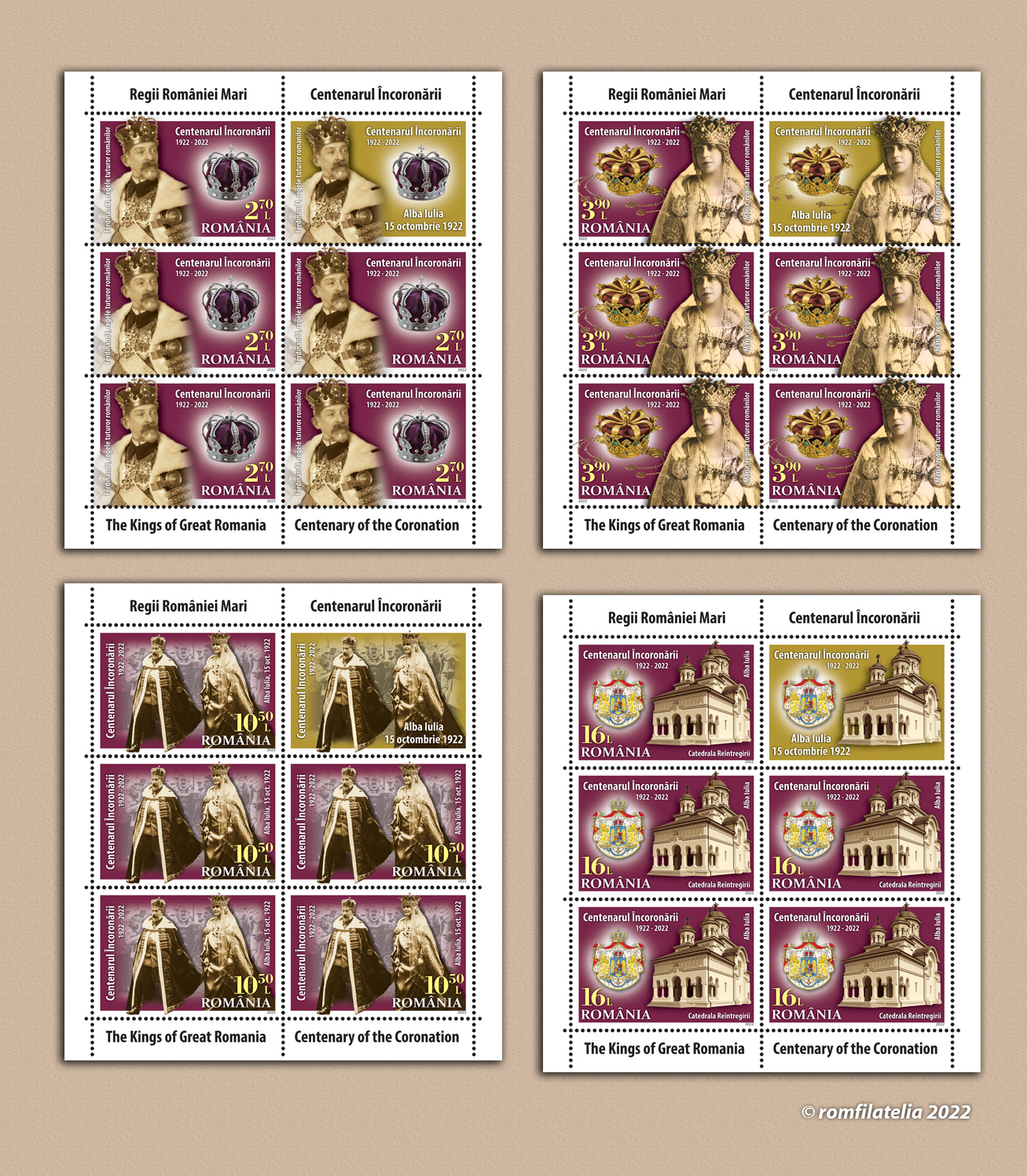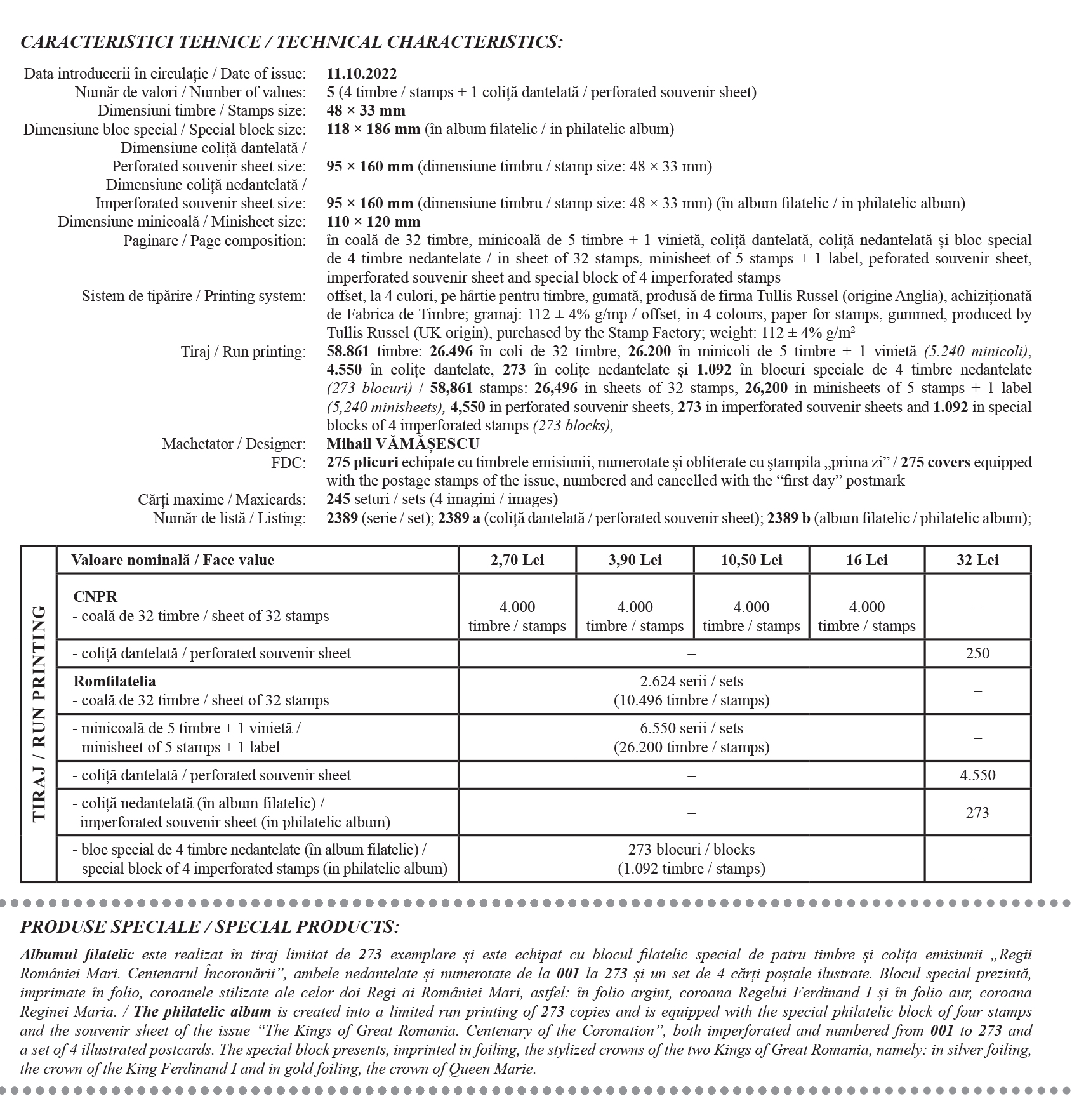 Consistent with its mission of promoting the values of national history, Romfilatelia pays a well-deserved and precious tribute to the two monarchs of Great Romania, King Ferdinand I and Queen Marie, by dedicating the postage stamps issue The Kings of Great Romania. Centenary of the Coronation.
Consistent with its mission of promoting the values of national history, Romfilatelia pays a well-deserved and precious tribute to the two monarchs of Great Romania, King Ferdinand I and Queen Marie, by dedicating the postage stamps issue The Kings of Great Romania. Centenary of the Coronation.
The issue, consisting of four postage stamps, a perforated souvenir sheet and a First Day Cover, will be introduced into circulation on Tuesday, October 11, this year, in Iași, the historical capital of Romania between 1916 and 1918, the place where the first decisions and historical documents were recorded to bring the first Romanian lands to the borders of Great Romania, which inaugurated the Reunification of the Country.
On the four stamps of the issue, with the face values of Lei 2.70, Lei 3.90 lei, Lei 10.50 lei and Lei 16, the portraits of the crowned kings Ferdinand I and Queen Marie are illustrated, together with their crowns, or in pairs, as well as the Reunification Cathedral, from Alba Iulia.
The Proclamation presented by King Ferdinand I, on the occasion of the Coronation ceremony on October 15, 1922, is reproduced on the background of the perforated souvenir sheet, with the face value of Lei 32.
The issue is completed by a limited-edition collection philatelic album and a set of four maxicards for maximaphilia enthusiasts.
After the historic decisions adopted through the peace treaties of Versailles, Saint-Germain, Neuilly, Trianon and Sèvres, the borders of Great Romania were internationally established, starting on June 4th, 1920.
The festive moment, which should have ceremoniously established the status of the Kingdom of Romania after the achievement of the Great Union in 1918, was in the attention of the Averescu government since 1921. The commission set up this year to organize the event, led by General Coandă, included great personalities of those times, among which Nicolae Iorga, George Enescu, Nicolae Titulescu, Anghel Saligny, the architect Victor Ștefănescu, the future patriarch Miron Cristea.
For the coronation ceremony, scheduled for 1922, it was decided to start the construction of the Orthodox Cathedral in Alba Iulia, whose foundation stone was laid in March 1921.
After the erection of the building in a record time, of only 10 months, under the care of the mayor of Alba Iulia, Aurel Sava and under the guidance of the architect Victor Ștefănescu, the interior paintings were executed until the fall of 1922 with the direct support and coordination of the painter Costin Petrescu, known especially for making the huge mural painting that can be found under the dome of the Romanian Athenaeum.
As part of the planning for the arrangement of venues suitable for the festive moment, buildings were rehabilitated, a park was laid out and visible intervention was made to change the facades and the interior appearance of the places where the official banquets were to be held. The city’s small station, provided with only 2 railway lines, benefited from an extension of up to 20 lines, on which no less than 14 trains had to run to ensure the Bucharest-Alba Iulia rides.
Sunday, October 15th, 1922, chosen as the date of the Coronation, was a rainy day, considered by the participants as an auspicious sign, recalling the same situation encountered when King Carol I arrived in Bucharest on May 10th, 1866. The rain stopped before the Royal train arrived in Alba Iulia city railway station. From the railway station, the sovereigns of Romania left for the place of the ceremony in a carriage drawn by four horses. The King and Queen were led into the Coronation church, in whose Altar were the Steel Crown (Crown of Independence) for King Ferdinand I and the Blue Crown (made in Paris, from Transylvanian gold, donated by a gold mine owner) for the Queen Marie.
The coronation proper took place outside, under a canopy, in the presence of many participants. During the ceremony, after taking the oath, King Ferdinand I received the Royal Crown from the President of the Senate and placed it alone on his head. Then the president of the Chamber of Deputies handed King Ferdinand I the queen’s crown. The king crowned his kneeling spouse. For minutes, an explosion of cheers accompanied the wish: “Long live the Sovereigns of Great Romania”. After the ceremony, the King delivered the “Proclamation to the Country”, later relayed by four announcers strategically placed at four points of the Citadel. The king gives a eulogy to the ancestors expressing himself as follows: “Putting on my head, in this ancient fortress of Roman Dacia, the crown of Plevna, which new and praiseworthy battles have made forever the crown of Great Romania, I worship with reverence to the memory of those who, in all times and everywhere through their faith, through their work and sacrifice, ensured national unity and I greet with love those who proclaimed it with one voice and one feeling from the Tisza to the Dniester and to the Sea”.
After a grandiose military parade held in the presence of the Sovereigns of Great Romania, in the western part of the Citadel, immediately after the official dinner, attended by representatives of the royal houses of England, Italy, Spain and ministers plenipotentiary from many countries, the Royal Couple returned to Bucharest. Here, on October 16th, 1922, they passed under the Arc de Triomphe. A Te Deum followed at the Metropolis, and then the parade from the University Square, in front of the statue of Michael the Brave.
Currently, the two crowns of the Sovereigns of Romania, located at the National Museum of Romanian History in Bucharest, look like this: The Steel Crown of King Carol I, also worn by King Ferdinand I (which has added three precious stones representing the provinces united with the Motherland: Bessarabia, Bukovina and Transylvania) and the Golden Crown of Queen Marie, which has the heraldic symbol of Romania (left side) and the heraldic symbol of the Queen’s Royal House (right side) inscribed on the side pendants.
Romfilatelia thanks the Library of the Romanian Academy, the Romanian Patriarchate, the National Museum of the Union in Alba Iulia, the National History Museum of Romania and the National Archives of Romania, for the documentary and photographic support given to the development of this postage stamps issue.



